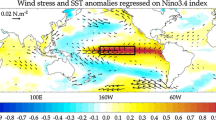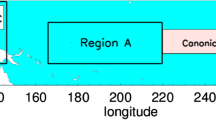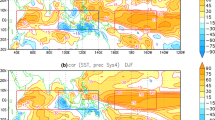Abstract
In this modelling study, the teleconnections of ENSO are studied using an atmospheric general circulation model (AGCM), HadAM3. The influence of sea surface temperature anomalies (SSTAs) remote from the tropical Pacific but teleconnected with ENSO is investigated. Composite cycles of El Niño and La Niña SSTs are created and imposed on HadAM3. These SSTs are imposed in different areas, with climatological SSTs elsewhere, in order to find the influences of SSTs in different regions. It is found that most of the reproducible response to ENSO is forced directly from the tropical Pacific before the peak of the event. However, during the peak and decay of ENSO, remote SSTs become increasingly influential throughout the tropics (at the 98% significance level). This could lead to extended ENSO-related predictability due to the memory of the remote oceans. The Indian Ocean and Maritime Continent SSTs are found to be particularly influential. Indian Ocean SSTAs dampen the teleconnections from the tropical Pacific and force the atmosphere above the tropical Atlantic. More generally, when a tropical SSTA is imposed, atmospheric anomalies are forced locally with anomalies of the opposite sign to the west. Some of the reproducible response to ENSO in the tropical Atlantic is forced, not directly from the tropical Pacific but from the Indian ocean, which in turn is forced by the tropical Pacific. Subsequently, delayed SSTAs in the tropical Atlantic damp the local response and force the atmosphere above the tropical Pacific in the opposite manner.













Similar content being viewed by others
References
Alexander M (1992) Midlatitude atmosphere-ocean interaction during El Niño. Part I: The North Pacific Ocean. J Clim 5: 944–958
Alexander M, Blade I, Newman M, Lanzante J, Lau N-C, Scott J (2002) The atmospheric bridge: The influence of ENSO teleconnections on air-sea interaction over the global oceans. J Clim 15: 2205–2231
Barsugli J, Sardeshmukh P (2002) Global atmospheric sensitivity to tropical SST anomalies throughout the Indo-Pacific basin. J Clim 15: 3127–3442
Becker B, Slingo J, Ferranti L, Molteni F (2001) Seasonal predictability of the Indian summer monsoon: what role do land surface conditions play? MAUSAM 52: 175–190
Bjerknes J (1972) Large-scale atmospheric response to the 1964–65 Pacific equatorial warming. J Phys Oceanogr 2: 212–217
Brankovic C, Palmer T, Ferranti L (1994) Predictability of seasonal atmospheric variations. J Clim 7: 217–237
Charney J, Shukla J (1981) Predictability of monsoons. In: Lighthill J, Pearce R (eds) Monsoon dynamics. Cambridge University Press, Cambridge, UK, chap. 6
Covey C, Abe-Ouchi A, Boer G, Boville B, Cubasch U, Fairhead L, Flato G, Gordon H, Guilyardi E, Jiang X, Johns T, Le Treut H, Madec G, Meehl G, Miller R, Noda A, Power S, Roeckner E, Russell G, Schneider E, Stouffer R, Terray L, von Storch J (2000) The seasonal cycle in coupled ocean-atmosphere general circulation models. Clim Dyn 16: 775–787
Davey M, Huddleston M, Sperber K, Braconnot P, Bryan F, Chen D, Colman R, Cooper C, Cubasch U, Delecluse P, DeWitt D, Fairhead L, Flato G, Gordon C, Hogan T, Ji M, Kimoto M, Kitoh A, Knutson T, Latif M, Treut HL, Li T, Manabe S, Mechoso CR, Meehl G, Oberhuber J, Power S, Roeckner E, Terray L, Vintzileos A, Voss R, Wang B, Washington W, Yoshikawa I, Yu J-Y, Yukimoto S, Zebiak S (2002) STOIC: a study of coupled model climatology and variability in tropical ocean regions. Clim Dyn 18: 403–420
Fennessy M, Shukla L (1999) Impact of initial soil wetness on seasonal atmospheric prediction. J Clim 12: 3167–3180
Ferranti L, Molteni F, Palmer T (1994) Impact of localized tropical and extratropical SST anomalies in ensembles of seasonal GCM integrations. Q J R Meteorol Soc 120: 1613–1645
Frederiksen C, Balgovind R (1994) The influence Of The Indian-Ocean Indonesian SST gradient on the Australian winter rainfall and circulation in an atmospheric GCM. Q J R Meteorol Soc 120: 923–952
Gill A (1980) Some simple solutions for heat-induced tropical circulation. Q J R Meteorol Soc 106: 447–462
Goddard L, Graham N (1999) Importance of the Indian Ocean for simulating rainfall anomalies over eastern and southern Africa. J Geophys Res 104: 19,099–19,116
Graham R, Evans A, Mylne K, Harrison M, Robertson K (2000) An assessment of seasonal predictability using atmospheric general circulation models. Q J R Meteorol Soc 126: 2211–2240
Gregory D, Rowntree P (1990) A mass flux convection scheme with representation of cloud ensemble charateristics and stability-dependent closure. Mon Weather Rev 118: 1483–1506
Hoerling MP, Hurrell J, Xu T (2001) Tropical origins for recent North Atlantic climate change. Science 292: 90–92
Hoskins B, Karoly D (1981) The steady linear response of a spherical atmosphere to thermal and orographic forcing. J Atmos Sci 38: 1179–1196
Hoskins B, Neale R, Rodwell M, Yang G (1999) Aspects of the large-scale tropical atmospheric circulation. Tellus Series A: Dyn Meteorol Oceanogr 51: 33–44
Kalnay E, Kanamitsu M, Kistler R, Collins W, Deaven D, Gandin L, Iredell M, Saha S, White G, Woollen J, Zhu Y, Leetmaa A, Reynolds B, Chelliah M, Ebisuzaki W, Higgins W, Janowiak J, Mo K, Ropelewski C, Wang J, Jenne R, Joseph D (1996) The NCEP/NCAR Reanalysis 40-year Project. Bull Am Meteorol Soc 77: 437–471 Web site http://www.cdc.noaa.gov
Klein S, Soden B, Lau N (1999) Remote sea surface temperature variations during ENSO: evidence for a tropical atmospheric bridge. J Clim 12: 917–932
Koster R, Dirmeyer P, Hahmann A, Ijpelaar R, Tyahla L, Cox P, Suarez M (2001) Comparing the degree of land-atmosphere interaction in four atmospheric general circulation models. J Hydrometeorol 3: 363–375
Kumar A, Hoerling M (1998) Specification of regional sea surface temperatures in atmospheric general circulation model simulations. J Geophys Res 103: 8901–8907
Kumar A, Hoerling M, Leetma M, Sardeshmukh P (1996) Assessing a GCM’s suitability for making seasonal predictions. J Clim 9: 115–129
Latif M, Anderson D, Barnett T, Cane M, Kleeman R, Leetma A, O’Brien J, Rosati A, Schneider E (1998) A review of the predictability and prediction of ENSO. J Geophys Res 103: 14375–14313
Latif M, Dommenget D, Dima M, Grötzner A (1999) The role of Indian Ocean sea surface temperature in forcing East African rainfall anomalies during December-January 1997/98. J Clim 12: 3497–3504
Latif M, Sperber K, Arblaster J, Braconnot P, Chen D, Colman A, Cubasch U, Cooper C, Delecluse P, DeWitt D, Fairhead L, Flato G, Hogan T, Ji M, Kimoto M, Kitoh A, Knutson T, Le Treut H, Li T, Manabe S, Marti O, Mechoso C, Meehl G, Power S, Roeckner E, Sirven J, Terray L, Vintzileos A, Voss R, Wang B, Washington W, Yoshikawa I, Yu J, Zebiak S (2001) ENSIP: the El Niño simulation intercomparison project. Clim Dyn 18: 255–276
Lau N-C, Nath M (1994) A modelling study of the relative roles of tropical and extratropical SST anomalies in the variability of the global atmosphere-ocean system. J Clim 7: 1184–1207
Lau N-C, Nath M (1996) The role of the “atmospheric bridge” in linking tropical Pacific ENSO events to extratropical SST anomalies. J Clim 9: 2036–2057
Matthews A (2003) Intraseasonal variability over tropical Africa during northern summer. J Clim (in press)
Molteni F, Ferranti L (2000) Non-linear aspects of the systematic errors of the ECMWF Coupled model. Technical report, ECMWF (2000)
Neale RB (1999) A study of the tropical response in an idealised global circulation model. Phd Thesis, University of Reading, Earley Gate, PO Box 243, Reading, RG6 6BB, UK
Nicholls N (1989) Sea surface temperatures and Australian winter rainfall. J Clim 2: 965–973
Pan Y, Oort A (1990) Correlation analyses between SST anomalies in the E. equatorial Pacific and the world Ocean. Clim Dyn 4: 191–205
Parker DE, Folland CK, Jackson M (1995) Marine surface temperature: observed variations and data requirements. Clim Change 31: 559–600
Pope V, Gallani M, Rowntree P, Stratton R (2000) The impact of new physical parameterisations in the Hadley Centre climate model: HadAM3. Clim Dyn 16: 123–146
Renshaw A, Rowell D, Folland C (1998) Wintertime low-frequency weather variability in the North Pacific-American sector 1949–93. J Clim 11: 1073–1091
Sardeshmukh P, Compo G, Penland C (2000) Changes in probability associated with El Niño. J Clim 13: 4268–4286
Schneider E, Bengtsson L, Hu Z-Z (2003) Forcing of northern hemisphere climate trends. J Atmos Sci 60: 1504–1521
Shukla J, Paolino D, Straus D, de Witt D, Fennessy M, Kinter J, Marx L, Mo R, (2000) Dynamical seasonal predictions with the COLA atmospheric model. Q J R Meteorol Soc 126: 2265–2299
Spencer H, Slingo J (2003) The simulation of peak and delayed ENSO teleconnections. J Clim 16: 1757–1774
Taylor KE (2001) Summarising multiple aspects of model performance in a single diagram. J Geophys Res 106: 7183–7192
Trenberth K, Branstator G, Karoly D, Kumar A, Lau N-C, Ropelewski C (1998) Progress during TOGA in understanding and modeling global teleconnections associated with tropical sea surface temperatures. J Geophys Res 103: 14,291–14,324
Venzke S, Latif M, Villwock A (2000) The coupled GCM ECHO-2. Part II: Indian ocean response to ENSO. J Clim 13: 1371–1383
Woolnough S, Slingo J, Hoskins B (2001) The organisation of tropical convection by intraseasonal sea surface temperature anomalies. Q J R Meteorol Soc 127: 887–907
Acknowledgements
Some HadAM3 model results and the GISST sea surface temperature dataset were provided by the UK Meterological Office. H. Spencer and J. Slingo acknowledge support through the Natural Environment Research Council (NERC)-funded UK Universities’ Global Atmospheric Modelling Programme and H. Spencer also received support from the Meterological Office through a CASE studentship. We are very grateful to Meterological Office staff who gave access to their data and to the CGAM tropical group who helped us to understand it. Thanks also to Lisa Goddard and two anonymous reviewers for comments on the manuscript.
Author information
Authors and Affiliations
Corresponding author
Rights and permissions
About this article
Cite this article
Spencer, H., Slingo, J.M. & Davey, M.K. Seasonal predictability of ENSO teleconnections: the role of the remote ocean response. Climate Dynamics 22, 511–526 (2004). https://doi.org/10.1007/s00382-004-0393-1
Received:
Accepted:
Published:
Issue Date:
DOI: https://doi.org/10.1007/s00382-004-0393-1




